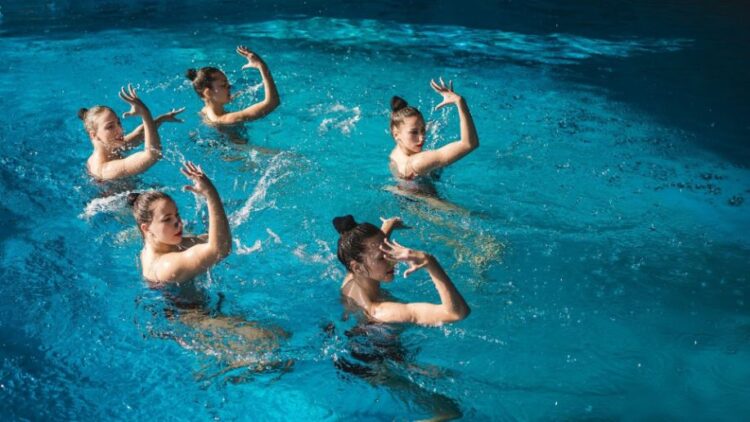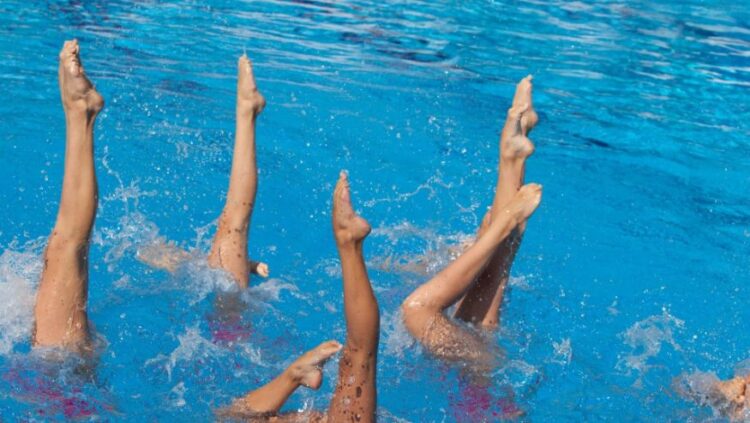
OBJECTIVE OF SYNCHRONIZED SWIMMING: Athletes perform artistic swimming routines in a pool, and receive the most amount of points possible from a panel of judges.
NUMBER OF PLAYERS: 1-8 players per team
MATERIALS: Costume, nose clip, waterproof beauty products
TYPE OF GAME: Sport
AUDIENCE: 6+
OVERVIEW OF SYNCHRONIZED SWIMMING
Synchronized swimming, also known as “artistic swimming”, is a water sport in which competitors synchronize a routine to a musical track. This swimming discipline is essentially the aquatic equivalent of figure skating or artistic gymnastics, with the major difference being that these swimming routines focus heavily on the synchronization component of the performance, hence the name.
Synchronized swimming has been a popular sport since the late 1800s, with the sport’s first-recorded competition being held in Berlin, Germany, in 1891. Outside of these early competitions, many music and performance venues across Europe would feature on-stage water tanks in which a performer would stage a routine. During these times, this sport was known as “water ballet”. Named for their ballet leg position during their routines.
In the United States, synchronized swimming started gaining popularity as foreign performers showcased their talents in various New York venues in the early 1900s. Meanwhile, the sport’s popularity was slowly spreading south into the US from Canada, which was one of the first countries to develop swim clubs dedicated to the sport decades before. By 1939, the first-ever synchronized swimming competition held in the US took place at Wright Junior College in Chicago.
At the Olympics, synchronized swimming made its official appearance as a medal sport in 1984 with single and duet events. In 1996, the well-beloved team event made its Olympic debut, although the singles event was scrapped from the Olympic program.
In 2017 the sport was renamed artistic swimming by the International Swimming Federation, which was not a popular decision.
SETUP

EQUIPMENT
- Costume: Swimmers wear artistic suits/costumes that closely resemble those worn by gymnasts. Special costume-matching adornments are often worn on their heads as well. As expected, all of the gear is designed to handle being submerged in water.
- Nose Clip: Nose clips are worn by all swimmers to prevent water from entering their noses while spinning around underwater.
- Waterproof Beauty Products: Many swimmers outfit themselves with special hair gel and makeup to further the theme of their costumes. All of these products must be resistant to water.
EVENTS
Synchronized swimming competitions usually include three main events:
- Solo: Solo competitions include a single swimmer performing a choreographed routine synchronized to a music track. These events are no longer part of the Olympic Games, although they’re still held biannually in the World Aquatics Championships.
- Duet: Duet events involve two swimmers performing a coordinated routine to music.
- Team: Team events can include between four and eight swimmers (often on the high end of this range) who perform a routine that almost appears hypnotizing when done in perfect synchronization.
Each of these three events usually requires a team to perform two separate routines: a technical routine and a free routine. A technical routine requires the swimmers to complete a list of mandatory elements in their performance. Conversely, a free routine has no requirements and allows for full expression, creativity, and innovation.
GAMEPLAY

SCORING
All synchronized swimming routines are scored by three separate panels of five judges. Each judging panel scores a specific part of a performance, although this scoring criterion slightly differs between technical and free routines.
Each free and technical routines are scored out of a maximum of 100 points. Each judge provides a score between 0.0 and 10.0 for the specific performance element they’re judging. The highest and lowest score for each judging panel is discarded, and the three middle scores are added together for a maximum of 30 points.
However, one judging category is weighted more heavily than the other two. For this third judging category (“elements” for technical routines, “impression” for free routines), the three middle scores are still added together. However, they’re then divided by three and multiplied by four. This means a perfect score of 10 from the three middle judges would be worth 40 points instead of 30 points.
1) TECHNICAL ROUTINE SCORING
Technical routines are scored on elements, execution, and impression, with each scoring category being assigned to a different panel of judges.
- Elements (40% of total score): A score that reflects how well the swimmers performed the predetermined, mandatory elements of their routine.
- Execution (30%): This score reflects the execution and synchronization of all non-required elements in the routine.
- Impression (30%): A score that takes into account the difficulty of the performance, the creativity of its choreography, the way it’s presented, and how well it matches the music selected for the performance.
2) FREE ROUTINE SCORING
Free routines are scored very similarly to technical routines. However, since there are no required elements, this judging category is instead swapped with one dedicated to the performance’s difficulty.
- Execution (30% of total score): This score reflects the level of excellence displayed in the execution and synchronization of all performance elements.
- Difficulty (30%): This score reflects how difficult the routine is, taking into account its individual elements and synchronization elements.
- Impression (40%): This score reflects the overall artistic excellence of the performance and takes into account choreography, music interpretation, and how well the swimmers present their routine to the audience.
A team’s free routine and technical routine scores are added together to give them their final score used to place them on the podium. This means a perfect score is 200 points, with most medal winners scoring above 190 points.
PERFORMANCE TECHNIQUES
Throughout a synchronized swimming performance, swimmers must be able to maintain their body position above or below the water when necessary. To do this, swimmers must master two important techniques known as “sculls” and “eggbeaters”:
SCULLS
Sculls are hand movements used to propel the body in water. Most sculling techniques involve forearm movements and keeping the palms facing the bottom of the pool.
Sculls can be as basic as the ones used by everyday swimmers to stay afloat in a pool or as complex as “support sculls” used by synchronized swimmers to keep their upper bodies balanced underwater while their legs are in the air.
EGGBEATERS
Opposite to sculls, eggbeaters are the leg movements used by swimmers to stay afloat. The name of this technique references the motion of the swimmer’s legs—raising the knee up from the sides in an “out-to-in” motion and then straightening the leg by kicking down and slightly out to the sides. This circular motion is done by both legs, although they alternate paces, with one leg kicking while the other is being raised in front of the body (similar to two eggbeaters rotating with an electric mixer).
Special eggbeater kicks are also used to propel a swimmer’s body high out of the water, a move known as a “body boost”. These eggbeater kicks are crucial to a swimmer’s performance, allowing them to perform freely with their arms while keeping more than just their heads out of the water.
ROUTINE MOVES
There are several different moves that can be used in routines. Such include lifts, in which certain swimmers will lie on their backs in a layout position underwater, then interlink bodies to propel and flyer out of the water.
Another used move is the Bent Knee. In this position swimmers will keep their bodies in a vertical position. Then one leg remains vertical while the other is raised so that their toes are touching the vertical leg knee.
The Knight Position has a swimmer stay vertical with their head towards the bottom of the pool, then they must lift one leg so that it creates a vertical line perpendicular the water’s surface.
Watch these synchronized swimmers in the water to see these techniques in motion:
RULES
Throughout a performance, each swimmer must abide by a set of strict rules. Failure to follow these rules can result in point deductions or even disqualification for their entire team.
- Swimmers cannot touch the bottom of the pool for any reason.
- Swimmers cannot touch the sides/deck of the pool during their routine.
- A routine must be performed from start to finish without any pauses.
- All required technical routine elements must be performed exactly as they’re listed; an incorrect number of rotations, doing more than an element requires, or leaving out part of an element can carry major point deductions.
- Routines must be within the allowed time frame chosen by the competition organizers; this time frame ranges from two to four minutes, depending on the event.
A GENDER-LOCKED SPORT
Throughout its long history as a sport, synchronized swimming has been reserved for only female competitors. Although many countries allow men to compete in regional or national competitions, the World Aquatics Championships and Olympics prohibit men from competing. As of 2023, there appears to be no serious effort to change this.
RUSSIAN DOMINANCE
Since 2000, the Russians have completely dominated international synchronized swimming competitions. This includes Russia winning every single gold medal in duet and team events in the Olympic sport. Additionally, Russia has won almost every gold medal in solo, duet, and team competitions at the World Aquatics Championships held every two years.
END OF GAME
The team of swimmers with the highest combined score of their technical and free routines is the gold medal winner in synchronised swimming.
- 30 GAMES TO PLAY OVER TEXT - April 22, 2024
- 20+ FREE PRINTABLE BABY SHOWER GAMES - April 16, 2024
- 20+ College Party Games for the Best Night Ever! - April 2, 2024